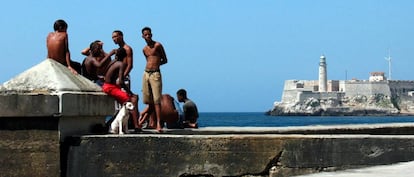As Cuba thaw continues, authorities announce Wi-Fi plan for Havana’s Malecón
Six-kilometer stretch of pier will get web access, while more and more Cubans are getting online


The Cuban government’s plan to roll out internet access on the island is one of the most attention-grabbing headlines in the country’s slow-moving process of political and economic liberalization. And the Raúl Castro administration has just announced a project that perfectly symbolizes this shift in policy: paid internet access along the Malecón in Havana before the end of the year.
The plan will cover six kilometers along the capital’s iconic pier, from Paseo del Prado to the mouth of the Almendares River, the western border of the downtown area. The government began to install Wi-Fi spots in Havana in July 2015 and extended the network throughout the busiest areas of the city. The authorities have also brought Wi-Fi technology to other Cuban cities.
An hour of internet connection costs two ‘pesos convertibles,’ or $2, a huge sum for most people in the country
Internet access is an astronomical shift that opens up different communication channels, an important step for a country where nearly every person has relatives living abroad and a society that has not had any information from the outside world for 50 years.
Access, however, is still difficult to come by. An hour of internet connection costs two pesos convertibles, or $2, a huge sum in a country where government employees make $20-30 a month – even if more and more people are earning extra money through private businesses. Coverage is patchy and websites that criticize the Cuban government are blocked.
Still, the need to communicate and the proverbial Cuban inventiveness has led to a growing number of people using the internet more frequently throughout the day. The government says 5% of the population uses the internet but the actual number of users is probably higher, especially in Havana and other large cities. Programs that allow several people to connect to one user’s signal help overcome certain obstacles.
The government says 5% of the population uses the internet but the actual number of users is probably higher
For now, the government continues to restrict internet access at home. Only a few public employees – professionals such as doctors and state journalists – and members of the foreign press obtain that privilege. But the administration is expected to loosen restrictions in the future. Several months ago, authorities announced a plan for a pilot program that will install internet access in private homes in Habana Vieja. Companies such as Google are in contact with Cuban officials in case the government eventually decides to develop the necessary infrastructure.
With internet access, the Malecón will become an even more popular meeting place for Havana residents. The dike was built a century ago and the area nearby become the most popular strolling spot in the city. Its multi-purpose benches offer a place to sit down for a chat, a drink or just to contemplate. The Malecón became “more than a parapet against the heavy sea,” wrote Leonardo Padura. The Malecón represents “the physical and psychological barrier where the dreams and possibilities of so many Cubans have ended or started.” And now, once Wi-Fi is finally installed, it will become the leading frontier in Cuba’s march into the digital age.
English version by Dyane Jean François.
Tu suscripción se está usando en otro dispositivo
¿Quieres añadir otro usuario a tu suscripción?
Si continúas leyendo en este dispositivo, no se podrá leer en el otro.
FlechaTu suscripción se está usando en otro dispositivo y solo puedes acceder a EL PAÍS desde un dispositivo a la vez.
Si quieres compartir tu cuenta, cambia tu suscripción a la modalidad Premium, así podrás añadir otro usuario. Cada uno accederá con su propia cuenta de email, lo que os permitirá personalizar vuestra experiencia en EL PAÍS.
¿Tienes una suscripción de empresa? Accede aquí para contratar más cuentas.
En el caso de no saber quién está usando tu cuenta, te recomendamos cambiar tu contraseña aquí.
Si decides continuar compartiendo tu cuenta, este mensaje se mostrará en tu dispositivo y en el de la otra persona que está usando tu cuenta de forma indefinida, afectando a tu experiencia de lectura. Puedes consultar aquí los términos y condiciones de la suscripción digital.
More information
Archived In
Últimas noticias
The complicated life of Francesca Albanese: A rising figure in Italy but barred from every bank by Trump’s sanctions
Half of Scotland is in the hands of 420 property owners
Pinochet’s victims grapple with José Antonio Kast’s rise in Chile
Reinhard Genzel, Nobel laureate in physics: ‘One-minute videos will never give you the truth’
Most viewed
- Pablo Escobar’s hippos: A serious environmental problem, 40 years on
- Why we lost the habit of sleeping in two segments and how that changed our sense of time
- Charles Dubouloz, mountaineering star, retires at 36 with a farewell tour inspired by Walter Bonatti
- Reinhard Genzel, Nobel laureate in physics: ‘One-minute videos will never give you the truth’
- The Florida Keys tourist paradise is besieged by immigration agents: ‘We’ve never seen anything like this’










































